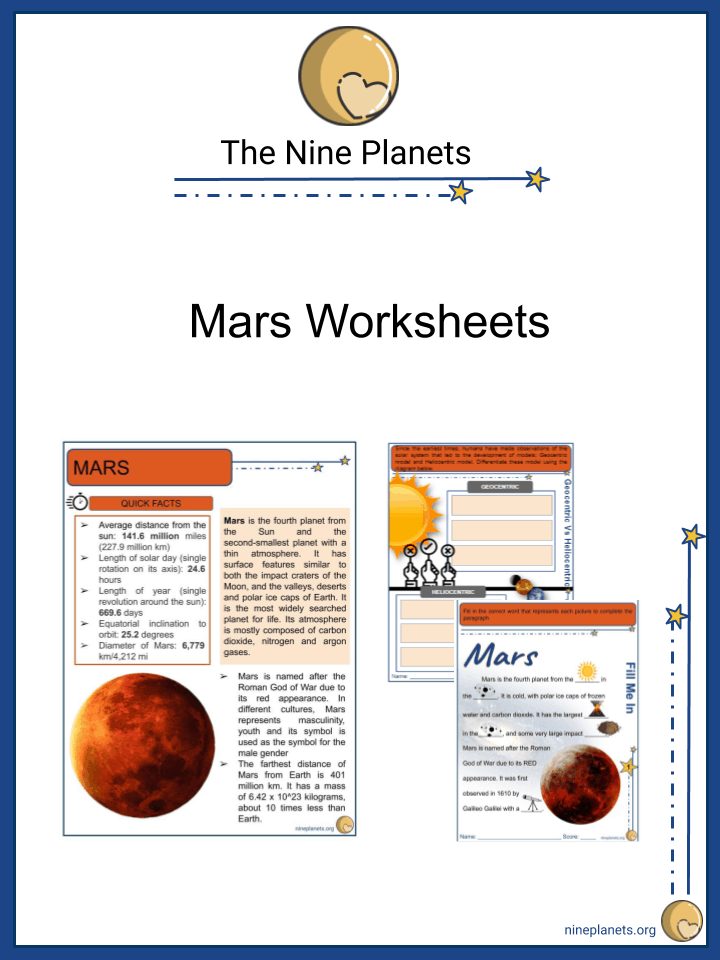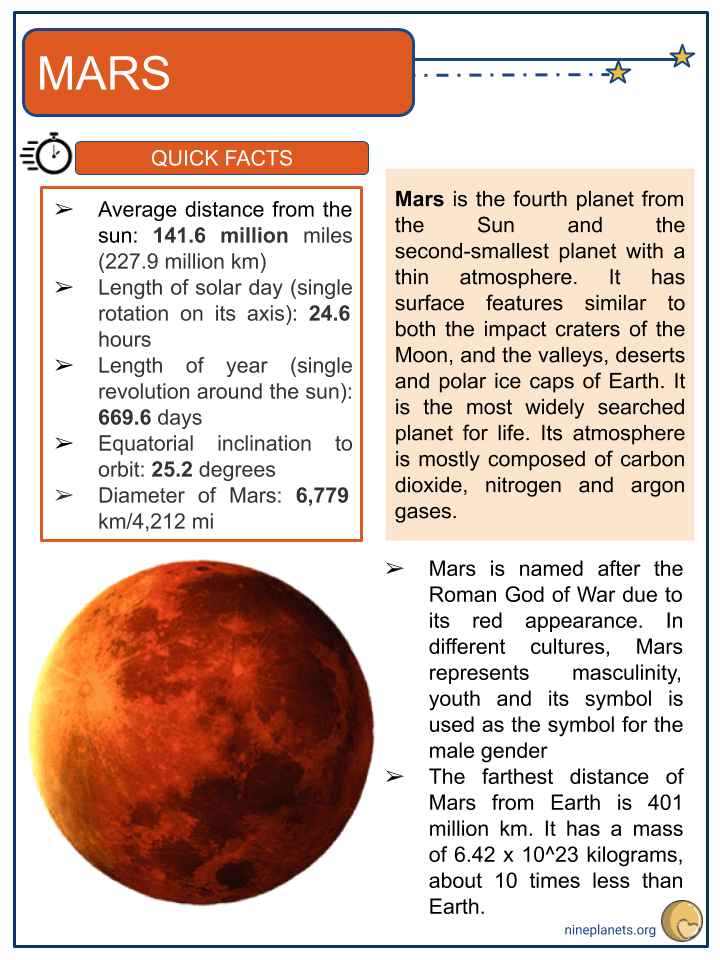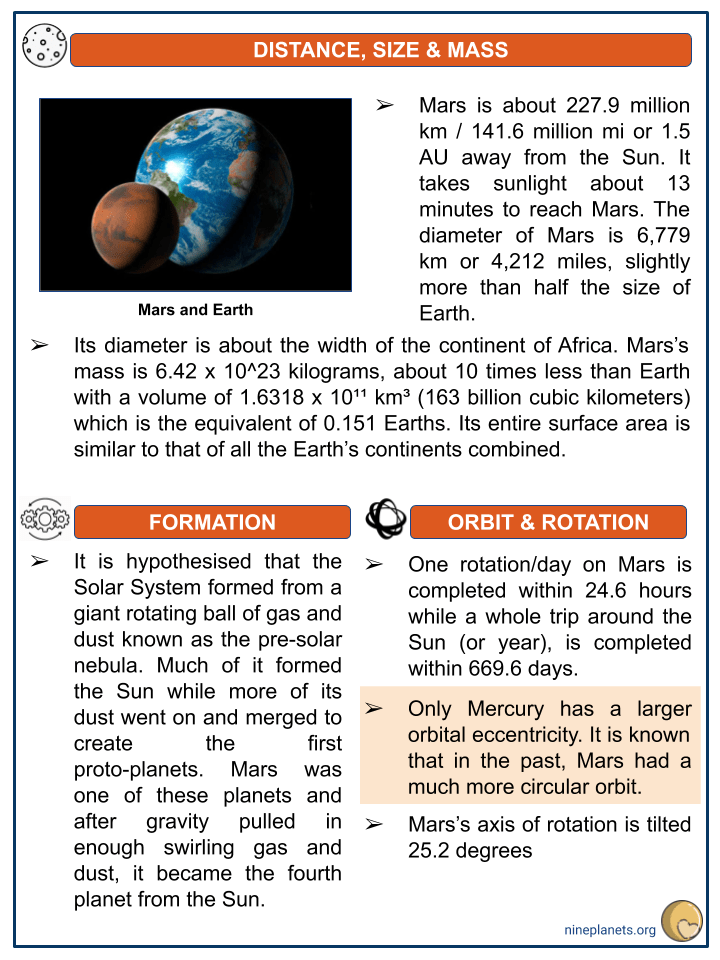Download Mars Worksheets
Click the button below to get instant access to these premium worksheets for use in the classroom or at a home.

This worksheet can be edited by Premium members using the free Google Slides online software. Click the Edit button above to get started.
Download free sample
Not ready to purchase a subscription yet? Click here to download a FREE sample of this worksheet pack.
Resource Examples
Click any of the example images below to view a larger version.




Key Facts & Information
- Mars is the fourth planet from the Sun and the second-smallest planet with a thin atmosphere. It has surface features similar to both the impact craters of the Moon, and the valleys, deserts and polar ice caps of Earth. It is the most widely searched planet for life. Its atmosphere is mostly composed of carbon dioxide, nitrogen and argon gases.
- Mars is named after the Roman God of War due to its red appearance. In different cultures, Mars represents masculinity, youth and its symbol is used as the symbol for the male gender
- The farthest distance of Mars from Earth is 401 million km. It has a mass of 6.42 x 10^23 kilograms, about 10 times less than Earth.
Quick Facts
- Average distance from the sun: 141.6 million miles (227.9 million km)
- Length of solar day (single rotation on its axis): 24.6 hours
- Length of year (single revolution around the sun): 669.6 days
- Equatorial inclination to orbit: 25.2 degrees
- Diameter of Mars: 6,779 km/4,212 mi
Observation
- Mars has been observed by many different cultures from around the world for hundreds of years.
- Detailed observations were made even by the Babylonians who developed arithmetic techniques to predict the future position of the planet while the ancient Greeks developed a geocentric model to explain the motions of the planets.
- In the 16th century, Nicolaus Copernicus proposed a heliocentric model for the Solar System in which the planets follow circular orbits around the Sun.
- In 1610, Galileo Galilei first observed Mars with a telescope.
- The idea of there being life on Mars started a long time ago, and this helped fuel the drive for searching for life upon Mars. From 1877 onward, it was mistakenly thought that water was found on Mars and later the idea of life became popularised among the public.
- Percival Lowell believed he could see a network of canals on Mars but they were proved to be optical illusions. Since then, many more details have been gathered about the planet, looking for any trace of life on Mars, even if it means finding evidence of past life.
Distance, Size & Mass
- Mars is about 227.9 million km / 141.6 million mi or 1.5 AU away from the Sun. It takes sunlight about 13 minutes to reach Mars. The diameter of Mars is 6,779 km or 4,212 miles, slightly more than half the size of Earth.
- Its diameter is about the width of the continent of Africa. Mars’s mass is 6.42 x 10^23 kilograms, about 10 times less than Earth with a volume of 1.6318 x 10¹¹ km³ (163 billion cubic kilometers) which is the equivalent of 0.151 Earths. Its entire surface area is similar to that of all the Earth’s continents combined.
Formation
- It is hypothesised that the Solar System formed from a giant rotating ball of gas and dust known as the pre-solar nebula. Much of it formed the Sun while more of its dust went on and merged to create the first proto-planets. Mars was one of these planets and after gravity pulled in enough swirling gas and dust, it became the fourth planet from the Sun.
Orbit & Rotation
- One rotation/day on Mars is completed within 24.6 hours while a whole trip around the Sun (or year), is completed within 669.6 days.
- Only Mercury has a larger orbital eccentricity. It is known that in the past, Mars had a much more circular orbit.
- Mars’s axis of rotation is tilted 25.2 degrees
Structure
- It is estimated that Mars has a dense core with a radius between 930-1,300 miles / 1,500 – 2,100 kilometers. It is made up primarily of iron and nickel with about 16-17% sulphur. The iron sulphide core is thought to be twice as rich in lighter elements than Earth’s. core.
- The core is surrounded by a silicate mantle which formed many tectonic plates and volcanic features on the planet that now appear to be dormant.
- Besides silicon and oxygen, the most abundant elements in the Martian crust are iron, magnesium, aluminum, calcium and potassium, an average thickness of the planet’s crust has been estimated to be about 50 km / 31 mi, with a maximum thickness of 125 km / 78 mi.
- Magnetosphere and Atmosphere. It is estimated that Mars lost its magnetosphere around 4 billion years ago.
- The atmosphere of Mars consists of about 96% carbon dioxide, 1.93% argon and 1.89% nitrogen, along with traces of oxygen and water. It is quite dusty. Recently methane has also been detected in the atmosphere, values of which indicate an active source of gas is present, be it biological or non-biological.
- Climate. If Mars had an Earth-like orbit, its seasons would be similar to Earth’s because its axial tilt is similar to Earth’s. In the northern hemisphere, the longest season is spring, lasting 194 days; while the shortest is autumn that lasts 142 days.
- Mars has the largest dust storms in the Solar System, reaching speeds of over 160 km/h (100 mph). These tend to occur when Mars is closest to the Sun, increasing global temperature.
Surface & Geology
- Though it is often referred to as the Red Planet, Mars has actually many colours. At the surface colours such as brown, gold and tan are present. Its surface is the same size as Earth’s dry lands combined, even though it is two times smaller.
- Mars has evidence of a watery past, with ancient river valley networks, lakebeds, rocks and minerals on the surface.
- Hydrology/Topography/Volcanoes. There are landforms visible that strongly suggest that liquid water has existed on the planet’s surface, such as Ma’adim Vallis, a valley of about 700 km / 430 miles thought to have been carved by flowing water long ago.
- Mars is scarred by a number of impact craters: a total of 43,000 craters with a diameter of 5 km.
- The largest crater confirmed is the Hellas impact basin, a light albedo feature clearly visible from Earth.
- The volcano Olympus Mons is an extinct volcano which contains several other large volcanoes. Olympus Mons is however the largest volcano detected in the entire Solar System, it has about three times the height of Mount Everest.
- Mars actually has avalanches. Cliffs towering above the surface that hold different materials can be dislodged in the spring when carbon dioxide thaws, creating tremendous cascades of rock and dust.
Moons
- Mars has only 2 known moons named Phobos and Deimos after the horses that pulled the chariot of Mars, the God of War. They are very small though.
- Phobos has a diameter of about 25 km or 15.5 mi, while Deimos just 15 km or 9.3 mi. They look very much like asteroids and it is strongly believed that they have been captured from the nearby asteroid belt by Mars’s gravity.
- Phobos orbits Mars only 6,000 km or 3,728 miles above the surface, moving so rapidly in its orbit that it orbits faster than Mars rotates.
- Tides from Mars are also altering its orbit, slowly lowering Phobos closer and closer to the surface. It is believed that in a few million years Phobos will drop low enough that it will actually enter the atmosphere and impact the surface.
Life Habitality
- On June 7, 2018, NASA announced that the Curiosity rover had discovered organic compounds in sedimentary rocks dating to three billion years old, indicating that some of the building blocks for life were present.
- In July 2018, scientists reported the discovery of a sub-glacial lake on Mars, the first known stable body of water on the planet. It sits 1.5 km (0.9 miles) below the surface at the base of the southern polar ice cap and is about 20 km (12 miles) wide.
- Out of all the planets in the Solar System, Mars appears to have the highest chance of having life forms but still the conditions are harsh enough that nothing should be able to survive there, perhaps only beneath the surface.
- Still, regardless of its habitability now, Mars was definitely once a planet filled with oceans and the right conditions for life.
Did You Know?
- Mars is the most intensely studied planet, with observations dating back to 4,000 years ago.
- It is about 50% further from the Sun than Earth.
- Perhaps second only to Venus when it comes to “visits”, Mars has been visited more than 16 times over about 39 attempts with the first successful mission happening in 1965 with the Mariner 4 spacecraft flyby.
- If you weigh 100kg on Earth, on Mars your weight would be 38kg.
- Theoretically, Mars is populated by robots since we sent so many there.
- On Mars, the Sun appears about half the size it does on Earth.
- A year on Mars is almost twice as long as a year on Earth.